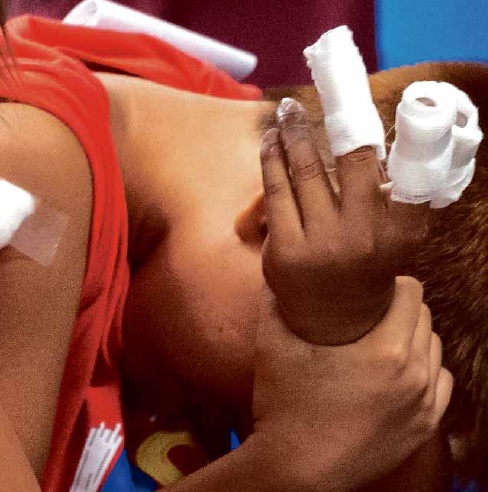Banned ‘piccolo’ still top cause of ’cracker-related injuries

A 13-year-old boy, Gabriel Pohanes, grimaces while
receiving a vaccine shot against tetanus after being injured by a firecracker
explosion during the New Year’s Eve revelry in 2016. Contributed photo / JILSON SECKLER TIU
Published: 12:54 p.m., Dec. 30, 2017 | Updated: 11:09 p.m., Dec. 30, 2017
Although it has been banned for more than five years, the “piccolo” firecracker is still the top cause of firecracker-related injuries because of its popularity among children.
According to the Department of Health (DOH), piccolo was behind 49 of the 77 firecracker-related injuries reported as of Dec. 30.
In its Aksyon: Paputok Injury Reduction 2017 report for Saturday, the DOH said 57 of the 77 incidents were caused by illegal fireworks.
This was followed by “boga,” also a banned firecracker, which was responsible for six injuries.
The DOH noted that while the 77 cases is 54 cases lower compared to the same period last year and 60-percent lower than the average over the past five years, the figure is still expected to rise.
Experience from previous years shows that cases of firecracker injuries peak during the New Year’s Eve revelry, but more cases are still reported one day later.
Metro Manila had the most number of injuries with 40 incidents, followed by Western Visayas with nine cases and the Bicol region with eight cases.
In Metro Manila, Manila had the highest number of cases at 22, followed by Mandaluyong City, Valenzuela City and Quezon City with four cases each.
Most of the injured, 74 of 77 cases, were males with the victims’ ages ranging from 11 months old to 62 years old. Most of the injuries were in the hands at 53 cases, followed by injuries to the eyes at 12 cases.
The DOH said most injuries did not require amputation, but there have already been four cases of amputations as of Saturday.
This year, the DOH hopes President Duterte’s Executive Order No. 28, which limits the use of firecrackers to community fireworks displays, will help reduce the number of injuries.
So far, the DOH has not yet recorded any cases of deaths, fireworks ingestion or stray bullet injuries.
Indiscriminate gunfire
The police is stepping up its operations against the indiscriminate firing of firearms that also causes fatalities every year.
Chief Insp. Andrea dela Cerna, the spokesperson of the Southern Mindanao Police Office, repeatedly warned trigger-happy individuals against discharging their weapons.
Except for Davao City, firecrackers have not been banned in areas such as Compostela Valley or Davao Occidental. However, its sale is strictly regulated.
In Davao City, where a firecracker ban had been in existence for more than 15 years, Mayor Sara Duterte said even those injured while setting off firecrackers will not be spared from jail time.
“If you will be injured while lighting a firecracker, you’ll just get an antitetanus shot and you will be hauled straight to jail. There will be no more admission to a hospital,” she added.
All over southern Mindanao, Dela Cerna said 3,258 policemen and other force multipliers have been deployed to ensure that the New Year’s revelry will be injury-free.
Safer firecrackers
Science and Technology Secretary Fortunato dela Peña urged the fireworks industry on Saturday to upgrade its technology to make its products safer, better and globally competitive.
Dela Peña said government scientists are now helping shape a modern fireworks production system in coordination with the Philippine Pyrotechnic Manufacturers and Dealers Association Inc. (PPMDAI).
“The fireworks business is lawful but only a handful of government agencies has been helping the industry,” said Celso Cruz, PPMDAI chair emeritus.
“There must be competent officials knowledgeable in the fireworks business. For the past 25 years, no one had a clue so no one gave a damn about the industry,” he complained.
Cruz said government inspectors have not been enforcing a ban on the use of potassium chlorate, a highly unstable chemical compound.
The compound is banned by Republic Act No. 7183, the law regulating the manufacture, sale and distribution of firecrackers and fireworks.
Sales on the last few days leading to Jan. 1, have been low, and many industry leaders blame the ambiguity of EO 28, which requires firecrackers to be set off only in safe zones designated by local governments. /jpv /pdi














